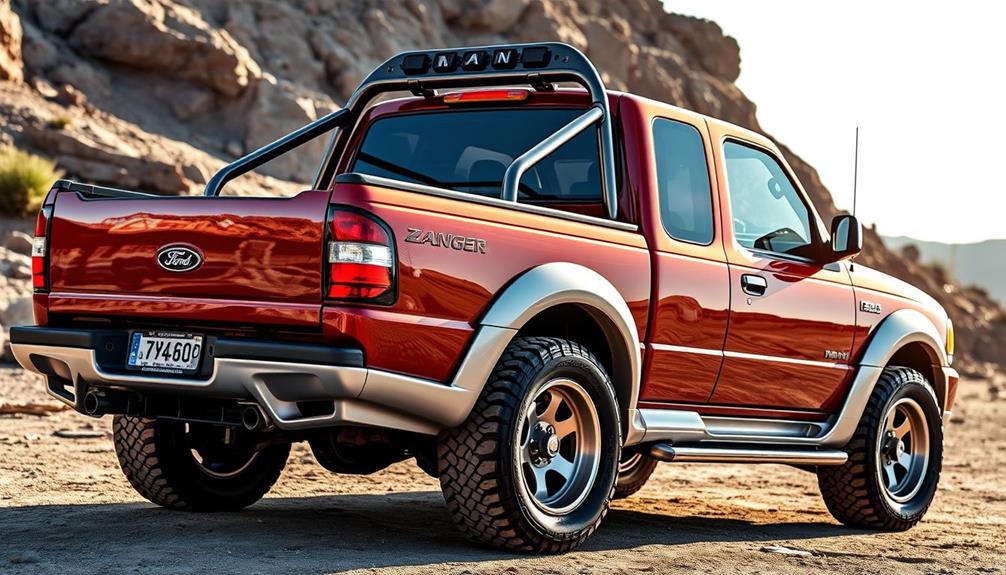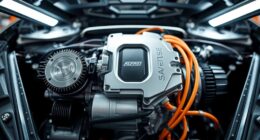To maximize the power of your 2002 Ford Explorer Sport Trac, start with performance upgrades like a K&N cold air intake and a Flowmaster 50 series exhaust. These can greatly boost horsepower and improve throttle response. Consider custom tuning with an SCT XCalibrator III for an optimized setup tailored to your driving style. Don't forget to maintain your vehicle with synthetic oil and check tire pressures for peak performance. Pairing these upgrades can result in considerable gains, and there are more strategies you can use to enhance your experience.
Key Takeaways
- Install a K&N Cold Air Intake to gain approximately 16.88 HP and improve overall engine efficiency.
- Upgrade to a Flowmaster 50 Series Exhaust for better airflow and an aggressive sound while enhancing throttle response.
- Use the SCT XCalibrator III for custom tuning to optimize performance and fuel efficiency tailored to your driving style.
- Replace the stock throttle body with a Zabteck upgrade to enhance airflow and improve power output significantly.
- Maintain regular fluid changes and tire pressure at 35 psi to sustain performance gains and improve fuel efficiency.
Performance Modifications Overview
When you're looking to boost the performance of your 2002-2006 Ford Explorer Sport Trac, several modifications can make a significant difference.
One of the first upgrades you should consider is a K&N cold air intake. This modification can provide an impressive horsepower gain of approximately 16.88 HP at 5243 RPM. By improving airflow to your engine, you'll notice a quicker throttle response and a more dynamic driving experience.
Next, upgrading the throttle body with Zabteck components can further enhance your vehicle's performance. This change will make your throttle response snappier, giving you better control and acceleration.
Another worthwhile addition is a Flowmaster 50 series exhaust system, which not only improves exhaust flow but also adds an aggressive sound that enhances your driving pleasure.
Lastly, consider investing in an SCT XCalibrator III tuner. This device optimizes your engine's performance and fuel efficiency by allowing you to customize the tuning based on your driving habits.
Don't forget that regular maintenance, like using synthetic oil and keeping tire pressure around 35 psi, is essential for getting the most out of these modifications.
Key Performance Gains

When you upgrade your Ford Explorer Sport Trac, focusing on air intake improvements, exhaust system enhancements, and tuning options can lead to significant performance gains.
For instance, a K&N air intake kit can boost horsepower, while a Flowmaster exhaust system improves engine efficiency.
Custom tuning with an SCT XCalibrator III can further optimize your setup, tailoring performance to your driving style.
Air Intake Improvements
Upgrading your Ford Explorer Sport Trac's air intake system can lead to impressive performance gains. For instance, installing a K&N Air Intake on a 2002-2006 model can yield around 16.88 horsepower at 5243 RPM, enhancing your engine's overall performance considerably.
One of the simplest improvements is removing the air box silencer, which boosts airflow and improves throttle response, making your driving experience more dynamic.
If you're looking for a cost-effective option, consider a drop-in K&N square filter. It provides better air filtration and performance compared to the stock filter without breaking the bank.
For those seeking more substantial upgrades, full intake kits that include throttle body enhancements from Zabteck can lead to remarkable throttle response improvements and increased power output.
Don't overlook the importance of regular maintenance, either. Utilizing high-quality synthetic oil can complement your air intake upgrades, maximizing your Sport Trac's performance even further.
With these adjustments, you'll enjoy a more powerful and responsive driving experience. So, get ready to release the potential of your SUV-truck hybrid!
Exhaust System Enhancements
A well-optimized exhaust system can greatly enhance your Ford Explorer Sport Trac's performance and driving experience. Upgrading to a Flowmaster 50 series exhaust, for instance, can considerably improve exhaust flow and give your SUV-truck hybrid a deeper, more aggressive sound. This enhancement leads to better throttle response and overall performance.
To take your upgrades further, consider installing high flow catalytic converters alongside your new exhaust system. This combination could yield a noteworthy increase of 12-13 horsepower, giving your Sport Trac an extra edge on the road.
Additionally, incorporating DNA short tube headers can facilitate increased exhaust scavenging, promoting better engine performance overall.
Don't overlook the benefits of modifying your exhaust setup with an aftermarket Y-pipe. This tweak can optimize flow even more, releasing additional horsepower and torque from your 4.0L V6 engine.
A well-designed exhaust system not only maximizes power but can also improve fuel efficiency by reducing engine strain, especially when paired with other performance modifications like cold air intakes.
With these enhancements, your Ford Explorer Sport Trac will perform better than ever.
Tuning and Calibration Options
Tuning and calibration options can make a significant difference in the performance of your Ford Explorer Sport Trac. One of the best tools for this is the SCT XCalibrator III, which provides custom tuning tailored to your vehicle. This can boost both performance and fuel efficiency, giving you more power on demand.
Additionally, many enthusiasts report that unexpected issues during modifications can lead to silly tantrums and humorous moments that make the process more enjoyable.
Upgrading your intake system with full kits from K&N can yield impressive horsepower gains, with reports showing an increase of up to 16.88 HP at 5243 RPM.
Additionally, consider a throttle body upgrade from Zabteck to optimize airflow and improve throttle response, further enhancing your SUV-truck hybrid's power.
Don't forget about regular maintenance; using high-quality synthetic oils like Mobil 1 or Royal Purple can enhance engine performance and longevity.
Plus, modifying your exhaust system with components like the Flowmaster 50 series can improve exhaust flow and reduce back pressure, boosting both sound and power.
Budgeting for Upgrades

Transforming your Ford Explorer Sport Trac into a performance powerhouse doesn't have to break the bank. With a budget of around $1,500, you can make several impactful upgrades without significant financial strain.
Start your journey with a K&N air intake kit, which you can find for about $220. This affordable addition can boost both horsepower and gas mileage, enhancing your overall driving experience. Additionally, exploring various best websites to earn money online could provide you with extra funds for your upgrades.
Next, consider investing in a throttle body upgrade and a cold air intake. These modifications can yield substantial performance returns, making your SUV-truck hybrid even more enjoyable to drive.
For serious enthusiasts, custom tunes via the SCT XCalibrator III offer one of the best values in performance tuning and should definitely be on your list when budgeting for upgrades.
Lastly, don't overlook the importance of regular fluid changes and maintenance. Keeping your vehicle in top shape prevents additional costs down the line and guarantees your performance upgrades work effectively.
Community Insights and Recommendations

After mapping out your budget for upgrades, it's time to tap into the wealth of knowledge within the Ford Explorer Sport Trac community. Many members highly recommend K&N air intake systems for your 2002-2006 Sport Trac, claiming horsepower gains of about 16.88 HP at 5243 RPM. This upgrade can greatly enhance your SUV-truck hybrid's performance.
Additionally, you'll find that enthusiasts rave about the SCT XCalibrator III for performance tuning. They often mention it's the best value for boosting both mileage and power.
If you're looking for peak performance enhancements, consider combining the K&N air intake with throttle body upgrades from Zabteck.
Community discussions also highlight the benefits of aftermarket exhaust modifications, particularly the Flowmaster 50 series, which can provide that desirable sound and further increase power.
Don't forget, regular maintenance and fluid changes are essential to sustaining these performance gains from any modifications. Engaging with fellow owners can help you make informed decisions while ensuring your Sport Trac remains in peak condition.
General Improvement Tips

To get the most out of your Ford Explorer Sport Trac, consider implementing some straightforward improvement tips that can enhance both performance and efficiency.
First, maintain your tire pressure around 35 psi to optimize performance and improve miles per gallon. Under-inflated tires can drag down your fuel efficiency considerably.
Regularly changing fluids and using synthetic oil, like Amsoil or Royal Purple, will help enhance engine efficiency and longevity. A well-oiled engine runs smoother and uses less fuel.
Additionally, consider installing a K&N square drop-in filter. This cost-effective modification improves airflow and can boost performance without requiring extensive changes.
When driving on highways, keep your speed around 60 mph. This speed helps maximize miles per gallon, making your trips more economical.
Engine Specifications and Upgrades

The Ford Explorer Sport Trac's robust 4.0L V6 engine serves as a solid foundation for performance enthusiasts looking to enhance their ride.
With a powerful output of 245 horsepower and a dual timing chain design, this engine is built for reliability and efficiency. Its 60-degree angle layout, based on a previous pushrod design, utilizes roller rockers that contribute to improved performance.
To maximize your Sport Trac's power, consider a K&N cold air intake. This upgrade can provide an impressive boost of approximately 16.88 horsepower at 5243 RPM.
Additionally, exhaust modifications, like installing a Flowmaster 50 series muffler or high-flow catalytic converters, can considerably enhance both power and throttle response, making your driving experience more exhilarating.
Another effective upgrade is to replace your throttle body with one from Zabteck. This modification improves airflow, leading to noticeable performance gains.
By focusing on these key upgrades, you can transform your Ford Explorer Sport Trac into a more powerful and responsive vehicle.
With the right enhancements, you'll enjoy a sportier driving experience that truly reflects your performance aspirations.
Forced Induction Options

When it comes to boosting your Ford Explorer Sport Trac's performance, forced induction options like superchargers and turbochargers are game changers. Supercharger kits, such as those from Modbox, typically cost between $1,500 and $1,600 and can provide significant power boosts.
However, careful tuning is essential to maintain reliability. The M112 Cobra supercharger is another option, known for its performance potential but with reliability concerns if not managed properly.
When considering forced induction options, keep these points in mind:
- The 4.0L V6 engine can handle up to 9 pounds of boost.
- You can potentially achieve around 280 wheel horsepower at that boost level.
- Upgrading head studs is vital for applications exceeding 9 pounds of boost.
- Custom turbo or supercharger kits can greatly enhance performance.
- Proper planning and tuning are necessary to avoid potential failures.
Exhaust and Drivetrain Enhancements

Boosting your Ford Explorer Sport Trac's performance doesn't stop at forced induction; exhaust and drivetrain enhancements play a vital role too. Upgrading to a full exhaust system, which includes short tube headers and high-flow catalytic converters, can greatly improve airflow and horsepower. This upgrade allows your SUV-truck hybrid to breathe better, ultimately translating into more power on the road.
To enhance your exhaust note, consider installing a Flowmaster 50 series muffler. It provides a more aggressive sound while maintaining performance benefits, making your ride more enjoyable.
On the drivetrain side, implementing a limited slip differential upgrade can greatly improve traction and handling, addressing the one-wheel peel issue common in factory models.
Additionally, selecting ideal gearing ratios like 3.73 or 4.10 will enhance acceleration, especially when paired with forced induction. These changes guarantee that your Sport Trac delivers the performance you crave.
Don't forget regular maintenance of your exhaust system—check for leaks and confirm proper connections—to sustain your performance gains and prevent power loss.
Engaging With the Community

Connecting with fellow Ford Explorer Sport Trac enthusiasts can greatly enhance your tuning experience. Engaging with the community opens doors to valuable insights and firsthand experiences that can guide your modifications. Additionally, connecting with other enthusiasts can lead to discovering new and innovative ford transit connect tuning techniques and products. Whether it’s learning about the best performance upgrades or finding the most reputable tuning shops, being part of a passionate group can provide endless opportunities for enhancing your vehicle. By joining online forums, attending meetup events, or simply communicating with fellow enthusiasts, you can expand your knowledge and make the most of your tuning journey.
When you share your own performance upgrade journey, you inspire others and build camaraderie among Sport Trac owners.
Here are some key benefits of participating in these communities:
- Real-world advice: Get tips on tuning from those who've already tackled similar projects.
- Aftermarket part compatibility: Learn which parts work best for your specific model and year.
- Cost-effective upgrades: Discover budget-friendly modifications that deliver impressive performance gains.
- Latest trends: Stay updated on successful tuning strategies and popular modifications.
- Networking opportunities: Connect with local enthusiasts for meetups, car shows, or collaborative projects.
Frequently Asked Questions
How Much HP and Torque Does a Ford Explorer Hybrid Have?
You'll find that the Ford Explorer hybrid's horsepower and torque vary based on the model year. Typically, the hybrid system offers around 200 horsepower and torque similar to its gasoline counterpart, enhancing fuel efficiency rather than power.
How Many Miles per Gallon Does a Ford Explorer Sport Trac V6 Get?
You might be surprised to learn that the 2002 Ford Explorer Sport Trac V6 typically gets around 16 mpg in the city and 21 mpg on the highway, depending on your driving habits and maintenance practices.
How Much Horsepower Does the Ford Explorer Plug in Hybrid Have?
The Ford Explorer Plug-in Hybrid packs an impressive combined output of 457 horsepower. You'll enjoy an exhilarating driving experience, thanks to its powerful 3.3L V6 engine and electric motor working seamlessly together for maximum performance.
What Ford Explorer Has the Most Horsepower?
If you're looking for the Ford Explorer with the most horsepower, check out the 2004 model with the optional 4.6L V8 engine, delivering an impressive 292 horsepower for a thrilling driving experience.
Conclusion
By tuning your 2002 Ford Explorer Sport Trac, you can unleash its full potential and transform it into a more powerful and responsive SUV-truck hybrid. You might think tuning is too expensive or complicated, but with careful budgeting and community support, it's totally achievable. Plus, the satisfaction of enhancing your ride is worth it! Immerse yourself in the upgrades, connect with fellow enthusiasts, and enjoy the thrill of driving a truly unique vehicle. Your adventure starts now!









